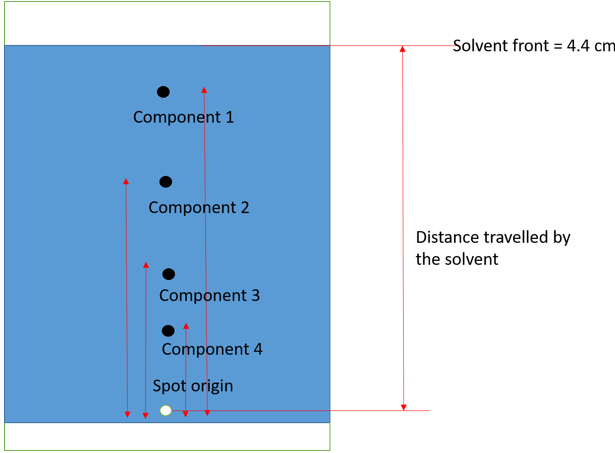This set of Enzyme Technology Multiple Choice Questions & Answers (MCQs) focuses on “Enzymes Purification – Thin Layer Chromatography”.
1. The presence of enzyme in the sample can be detected by _________________
a) gel exclusion chromatography
b) affinity chromatography
c) ion exchange chromatography
d) thin layer chromatography (TLC)
View Answer
Explanation: Enzyme which have been clarified and concentrated can be detected by thin layer chromatography. Gel exclusion, affinity and ion-exchange chromatography are used for purification of enzymes based on the property of the enzyme.
2. The method which relies on differences in partitioning behavior between a flowing mobile phase and a stationary phase to separate the components in a mixture is referred to as _________________
a) homogenization
b) dialysis
c) chromatography
d) ultrafiltration
View Answer
Explanation: In chromatography, there is a column which holds the stationary phase and mobile phase carrying the sample pass through it. The components in the sample which partition strongly in the stationary phase spend greater time in the column and get separated from the components which stay in the mobile and pass through the column faster. As the components get eluted, they may be quantified by a detector or collected for further analysis. Homogenization is a physical technique to separate out the cell components into the medium. Dialysis and ultrafiltration are the steps involved in enzyme purification.
3. Which chromatography technique consist of a stationary phase immobilized on a glass plate and an organic solvent acting as a mobile phase?
a) Ion exchange chromatography
b) Affinity chromatography
c) Thin layer chromatography (TLC)
d) Gel exclusion chromatography
View Answer
Explanation: In TLC, the stationary phase is immobilized on a glass plate and organic solvent act as the mobile phase. The sample dissolved in the solvent is placed on the stationary phase. The solvent mixture moves up by the capillary action and meet the sample mixture. Different compounds travel at different rates due to their solubility and interactions with the stationary phase absorbents. Gel exclusion, affinity and ion-exchange chromatography are used for purification of enzymes based on the property of the enzyme.
4. If the solvent phase in TLC was 80:20 mixture of hexane and ethyl acetate, the polar compounds will not move as much as non-polar compounds.
a) True
b) False
View Answer
Explanation: When the solvent is 80:20 mixture of hexane and ethyl acetate, the solvent will be mostly nonpolar. This means that the non-polar compounds will move further up the plate. In contrast the polar compounds will not have moved as much as the non-polar compounds. Hence the statement is true.
5. When the solvent phase in TLC is 20:80 mixture of hexane and ethyl acetate, the polar compounds will not move as much as non-polar compounds.
a) True
b) False
View Answer
Explanation: In TLC, when the mixture 20:80 mixture of hexane and ethyl acetate, the solvent will become mostly polar. This means polar compounds will move further up in the plate as compared to non-polar compounds. Hence the above statement is false.
6. Pick odd one out.
a) Silica gel
b) Alumina
c) Cellophane
d) Cellulose
View Answer
Explanation: The odd one out is cellophane which is a tubing kind of bag used in dialysis as a permeable membrane. Silica gel, Alumina and cellulose are the adsorbents used in TLC. Some other are acetylated cellulose, kieselghur etc.
7. What is the coloring agent used to detect laccase?
a) ABTS
b) Acetylated cellulose
c) Kieselghur
d) Hexane and Ethyl acetate mixture
View Answer
Explanation: The coloring agent used to detect laccase is ABTS. Acetylated cellulose and kieselghur are the adsorbents used in stationary phase of TLC. Hexane and ethyl acetate mixture is the solvent used as the mobile phase in TLC.
8. On spraying the coloring agent, the enzyme is detected as a __________
a) square
b) triangle
c) line
d) spot
View Answer
Explanation: After performing the TLC, the plate is sprayed with coloring agent and the protein or enzyme is detected as spot. The coloring agent used is ABTS which can detect laccase enzyme.
9. The ratio of distance travelled by the sample over the total distance covered by the solvent is referred to as ___________
a) solubility
b) miachelis menton constant
c) retention factor
d) volumetric throughput
View Answer
Explanation: Retention factors refers to the ratio of distance travelled by the sample to the distance travelled by the solvent. Volumetric throughput comes into picture when dealing with filtration. This is proportional to pressure and filter area and inversely proportional to filter cake thickness and dynamic viscosity. Solubility comes into picture when dealing with ammonium sulphate precipitation and is given by Log S = Kintercept – Salt T.
Miachelis Menton constant deals with enzyme kinetics is given by Km which is nothing but the substrate concentration when Vmax is reduced to half.
10. The below diagram shows the final result of a TLC. Given the distance travelled is 1.5 cm for component 3. Calculate the retention factor (Rf) of component 1.

a) 0.34
b) 0.79
c) 0.50
d) 0.39
View Answer
Explanation: Retention factor for component 3 is given by Rf
=\(\frac{distance \,travelled \,by \,component \,3}{distance \,travelled \,by \,the \,solvent}\)
Rf = 1.5/4.4 = 0.34.
Sanfoundry Global Education & Learning Series – Enzyme Technology.
To practice all areas of Enzyme Technology, here is complete set of 1000+ Multiple Choice Questions and Answers.
If you find a mistake in question / option / answer, kindly take a screenshot and email to [email protected]
- Check Enzyme Technology Books
- Practice Biotechnology MCQs
- Practice Chemical Engineering MCQs
- Check Biotechnology Books
- Check Chemical Engineering Books
